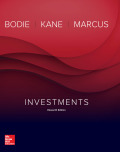
To calculate: The estimated rate of
Introduction: The expected rate of return is the value which is expected by the investor after the completion of the maturity period of the investment. This gives the security to the investor for his assumptions.
Answer to Problem 1PS
The expected
Explanation of Solution
Here, the expected rate of return is calculated as given below,
Return rate =
Now calculate
Now calculate factor
Now substitute the values of factor in equation, we get,
Hence the expected rate of return is 15.5 % for the firm.
Want to see more full solutions like this?
Chapter 10 Solutions
EBK INVESTMENTS
- Imagine that the SUNY Brockport Student Government Association (SGA) is considering investing in sustainable campus improvements. These improvements include installing solar panels, updating campus lighting to energy-efficient LEDs, and implementing a rainwater collection system for irrigation. The total initial investment required for these projects is $100,000. The projects are expected to generate savings (effectively, the cash inflows in this scenario) of $30,000 in the first year, $40,000 in the second year, $50,000 in the third year, and $60,000 in the fourth year due to reduced energy and maintenance costs. SUNY Brockport’s discount rate is 8%. What is the NPV of the sustainable campus improvements? (rounded) a- $70,213b- $48,729c- $45,865d- $62,040arrow_forwardImagine that the SUNY Brockport Student Government Association (SGA) is considering investing in sustainable campus improvements. These improvements include installing solar panels, updating campus lighting to energy-efficient LEDs, and implementing a rainwater collection system for irrigation. The total initial investment required for these projects is $100,000. The projects are expected to generate savings (effectively, the cash inflows in this scenario) of $30,000 in the first year, $40,000 in the second year, $50,000 in the third year, and $60,000 in the fourth year due to reduced energy and maintenance costs. SUNY Brockport’s discount rate is 8%. What is the NPV of the sustainable campus improvements? (rounded)a- $70,213b- $48,729c- $45,865d- $62,040arrow_forwardAfter many sunset viewings at SUNY Brockport, Amanda dreams of owning a waterfront home on Lake Ontario. She finds her perfect house listed at $425,000. Leveraging the negotiation skills she developed at school, she persuades the seller to drop the price to $405,000. What would be her annual payment if she opts for a 30-year mortgage from Five Star Bank with an interest rate of 14.95% and no down payment? 26,196 27,000 24,500 25,938arrow_forward
- Why should we care about the difference between book value and market value?arrow_forward1. A bond currently has a price of $1,050. The yield on the bond is 5%. If the yield increases 30 basis points, the price of the bond will go down to $1,035. The duration of this bond is closest to: Group of answer choices None of the above 6.0 5 4.5 5.5 2. A callable corporate bond can be purchased by the bond issuer before maturity for a price specified at the time the bond is issued. Corporation X issues two bonds (bond A and bond B) at the same time with thesame maturity, par value, and coupons. However, bond A is callable and bond B is not. Which bond will sell for a higher price and why? Group of answer choices Bond B; bond B should have the value of bond A minus the value of the call option Bond A; bond A should have the value of bond B plus the value of the call option Not enough information Bond A; bond A should have the value of bond B minus the value of the call option Bond B; bond B should have the value of bond A plus the value of the call optionarrow_forwardIn plain English, what is the Agency problem?arrow_forward
- HW Question 29: what is the difference between accounting and finance?arrow_forward1. You are assessing the average performance of two mutual fund managers with the Fama-French 3-factor model. The fund managers and the Fama-French factors had the following performance over this periodof time: Manager 1 Manager 2 Rm − rf smb hmlAvg. (total) Ret 27% 13% 8% 2% 6%βmkt 2 1 1 0 0s 1 -0.5 0 1 0h 1 0.5 0 0 1 The risk-free rate is 2%. What kinds of stocks does Manager 1 invest in? Group of answer choices Small-cap value stocks Large-cap value stocks Large-cap growth stocks Not enough information…arrow_forward1. A hedge fund currently invests in $100 million of mortgage-backed securities (MBS) that have a duration of 15 and convexity of -500 (negative five hundred). Which of the following is closest to how much money the fund would gain or lose if interest rates decreased by 1%, using the duration+convexity approximation? Group of answer choices Lose $12 million Lose $10 million Lose $12.5 million Gain $11 million Gain $12 million 2. A hedge fund currently invests in $100 million of mortgage-backed securities (MBS) that have a duration of 15 and convexity of -500 (negative five hundred). Suppose the Hedge fund financed their $100 million of MBS by using seven-day repurchase agreements in addition to their investors’ capital. Assuming they borrow the maximum amount, the required haircut is 10%, and the interest rate is 2% per year, which of the following is closest to how much interest they will owe at the end of the first seven-day term? Group of answer choices $35,000 $40,000 $30,000…arrow_forward
 EBK CONTEMPORARY FINANCIAL MANAGEMENTFinanceISBN:9781337514835Author:MOYERPublisher:CENGAGE LEARNING - CONSIGNMENT
EBK CONTEMPORARY FINANCIAL MANAGEMENTFinanceISBN:9781337514835Author:MOYERPublisher:CENGAGE LEARNING - CONSIGNMENT


